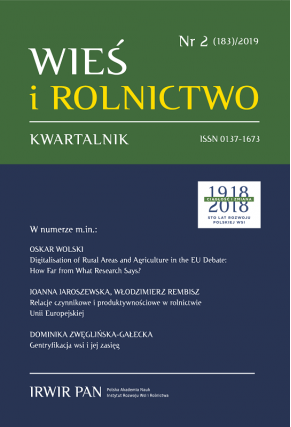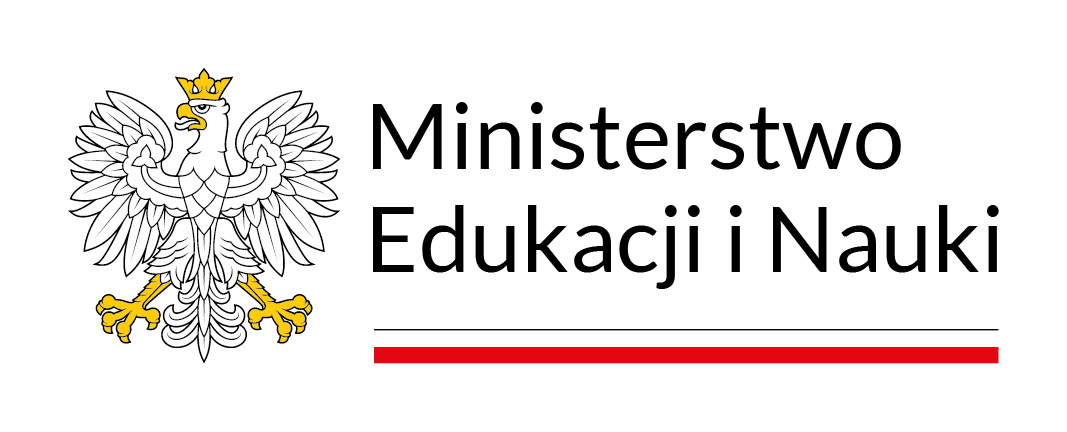Digitalisation of Rural Areas and Agriculture in the EU Debate: How Far from What Research Says?
DOI:
https://doi.org/10.53098/wir022019/01Słowa kluczowe:
digitalisation, rural areas, agriculture, rural development policy, EU policy, information and communication technology (ICT)Abstrakt
Digitalisation of rural areas and agriculture is a vital thread in the EU debate now, at the time of developing the 2021–2027 programming perspective and defining the CAP goals. However, in this debate selected geographic and social factors influencing the process of digitalisation–according to the literature–do not seem to be taken into account. This leads to simplifications and generalisations of the rural reality. Given that satisfying different groups of stakeholders in different areas of Europe poses a big challenge to any of the EU policy, efforts to make them more effective should be stepped up. This paper is to serve that role. Its main aim was to discuss the gaps in the EU debate on digitalisation of rural areas and agriculture. The simplifications and generalisations present in the debate come down to the marginalisation of the role of place and people in the process. These in turn stem from perceiving the rural reality through the prism of binary division of rural society and economy. The former is seen to be constituted by farmers and non-farmers, while the latter by agricultural and non-agricultural functions of rural areas.
Bibliografia
Akca H., Sayili M., Esengun K. (2007). Challenge of rural people to reduce digital divide in the globalized world: Theory and practice. Government Information Quarterly, 24 (2), 404–413. DOI: https://doi.org/10.1016/j.giq.2006.04.012
Andersson M., Klaesson J., Larsson J.P. (2016). How local are spatial density externalities? Neighbourhood effects in agglomeration economies. Regional Studies, 50 (6), 1082–1095. DOI: https://doi.org/10.1080/00343404.2014.968119
Baldock D., Dwyer J., Lowe P., Petersen J.E., Ward, N. (2001). The nature of rural development: Towards a sustainable integrated rural policy in Europe. London: Institute for European Environmental Policy.
Baptista R. (2001). Geographical clusters and innovation diffusion. Technological Forecasting and Social Change, 66 (1), 31–46. DOI: https://doi.org/10.1016/S0040-1625(99)00057-8
Dabinett G. (2000). Regenerating communities in the UK: getting plugged into the information society? Community Development Journal, 35 (2), 157–166. DOI: https://doi.org/10.1093/cdj/35.2.157
van Dijk J. (2006). Digital divide research, achievements and shortcoming. Poetics, 34 (4–5), 221–235. DOI: https://doi.org/10.1016/j.poetic.2006.05.004
van Dijk J. (2008). One Europe, digitally divided. In: A. Chadwick, Howard, P.N. (eds.). The Handbook of Internet Politics (pp. 288–304). London: Routledge. DOI: https://doi.org/10.4324/9780203962541-28
van Dijk J., Hacker K. (2003). The digital Divide as a complex and dynamic phenomenon. The Information Society, 19 (4), 315–326. DOI: https://doi.org/10.1080/01972240309487
Doong S.H., Ho S. (2012). The impact of ICT development on the global digital divide. Electronic Commerce Research and Applications, 11 (5), 518–533. DOI: https://doi.org/10.1016/j.elerap.2012.02.002
European Commission (EC) (2010a). Communication from the Commission to the European Parliament, the Council, the European Economic and Social Committee and the Committee of the Regions: A Digital Agenda For Europe. Brussels: European Commission, https://eur-lex.europa.eu/legal-content/EN/ALL/?uri=CELEX%3A52010DC0245R%2801%29 [accessed: March 2019].
European Commission (EC) (2010b). Communication from the Commission: Europe 2020: A Strategy for Smart, Sustainable and Inclusive Growth. Brussels: European Commission, https://eur-lex.europa.eu/legal-content/EN/ALL/?uri=celex:52010DC2020 [accessed: March 2019].
European Commission (EC) (2013). Communication from the Commission: EU Guidelines for the Application of State Aid Rules in Relation to the Rapid Deployment of Broadband Networks. Brussels: European Commission, https://eur-lex.europa.eu/legal-content/EN/TXT/?uri=uriserv:OJ.C_.2013.025.01.0001.01.ENG [accessed: March 2019].
European Commission (EC) (2016). Cork 2.0 Declaration: A Better Life in Rural Areas. Luxembourg: Publications Office of the European Union, https://enrd.ec.europa.eu/sites/enrd/files/cork-declaration_en.pdf [accessed: June 2019].
European Commission (EC) (2017). EU Action for Smart Villages, https://ec.europa.eu/agriculture/sites/agriculture/files/rural-development-2014-2020/lookingahead/rur-dev-small-villages_en.pdf [accessed: September 2018].
European Network for Rural Development (ENRD) (2018). Smart villages: Revitalising rural services. EU Rural Review, 26. Luxembourg: Publications Office of the European Union.
Elouna Eyenga P. (2019). The EIP-AGRI supports agricultural community in shaping its digital future by working together. https://www.iof2020.eu/blog/2019/03/eip-agri-supports-agricultural-community [accessed: March 2019].
Forman Ch., Goldfarb A., Greenstein S. (2005). How did location affect adoption of the commercial Internet? Global village vs. urban leadership. Journal of Urban Economics, 58, 389–420. DOI: https://doi.org/10.1016/j.jue.2005.05.004
Gillett S.E. (2000). Universal service: Defining the policy goal in the age of the Internet. The Information Society, 16 (2), 147–149. DOI: https://doi.org/10.1080/01972240050032906
Goggins S.P., Mascaro C.(2013). Context matters: The experience of physical, informational, and cultural distance in a rural IT firm. The Information Society, 29 (2), 113–127. DOI: https://doi.org/10.1080/01972243.2012.758212
Goldfarb A., Prince J. (2008). Internet adoption and usage patterns are different: Implications for the digital divide. Information Economics and Policy, 20 (1), 2–15. DOI: https://doi.org/10.1016/j.infoecopol.2007.05.001
Grimes S. (2003). The digital economy challenge facing peripheral rural areas. Progress in Human Geography, 27 (2), 174–193. DOI: https://doi.org/10.1191/0309132503ph421oa
Hage E., Roo J., van Offenbeek M., Boonstra A. (2013). Implementation factors and their effect on e-Health service adoption in rural communities: A systematic literature review. BMC Health Services Research, 13 (19), 1–16. DOI: https://doi.org/10.1186/1472-6963-13-19
Helsper E.J. (2012). A corresponding Fields model for the links between social and digital exclusion. Communication Theory, 22 (4), 403–426. DOI: https://doi.org/10.1111/j.1468-2885.2012.01416.x
Hite J. (1997). The Thunen model and the new economic geography as a paradigm for rural development policy. Review of Agricultural Economic, 19 (2), 230–240. DOI: https://doi.org/10.2307/1349738
van Huylenbroek G., Durand G. (eds.) (2003). Multifunctional agriculture: a new paradigm for European agriculture and rural development. Aldershot: Ashgate.
Ilomäki L., Kantosalo A., Lakkala M. (2011). What is digital competence? Linked portal. Brussels: European Schoolnet.
Janc K., Czapiewski K. (2013). The internet as a development factor of rural areas and agriculture – theory vs. practice. Studia Regionalia, 36, 89–105.
Koster H.R.A., van Ommeren J., Rietveld P. (2014). Is the sky the limit? High-rise buildings and office rents. Journal of Economic Geography, 14 (1), 125–153. DOI: https://doi.org/10.1093/jeg/lbt008
Lowe P., Murdoch J., Ward N. (1995). Networks in rural development beyond exogenous and endogenous models. In: J.D. van der Ploeg, G. van Dijk (eds.). Beyond modernisation: The impact of endogenous rural development (pp. 87–105). Assen: Van Gorcum.
Malecki E.J. (2003). Digital development in rural areas: Potentials and pitfalls. Journal of Rural Studies, 19, 201–214. DOI: https://doi.org/10.1016/S0743-0167(02)00068-2
Malecki E.J. (2010). Everywhere? The geography of knowledge. Journal of Regional Science, 50 (1), 493–513. DOI: https://doi.org/10.1111/j.1467-9787.2009.00640.x
Malecki E.J., Moriset B. (2008). The Digital Economy. Business Organization, Production Process and Regional Development. London: Routledge.
Marsden T. (1999). Rural futures: The consumption countryside and its regulation. Sociologia Ruralis, 39 (4), 501–520. DOI: https://doi.org/10.1111/1467-9523.00121
McCann P., Ortega-Argilés R. (2015). Smart specialization, regional growth and applications to European Union cohesion policy. Regional Studies, 49 (8), 1291–1302. DOI: https://doi.org/10.1080/00343404.2013.799769
McKibbon A.K. (2006). Systematic reviews and librarians. Library Trends, 55 (1), 202–215. DOI: https://doi.org/10.1353/lib.2006.0049
Mitzner T.L., Boron J.B., Fausset C.B., Adams A.E., Charness N., Czaja S.J., Sharit J. (2010). Older adults talk technology: Technology usage and attitudes. Computers in Human Behavior, 26 (6), 1710–1721. DOI: https://doi.org/10.1016/j.chb.2010.06.020
Murdoch J., Lowe P., Ward N., Marsden T. (2005). The Differentiated Countryside. Routledge Studies in Human Geography. London: Routledge.
Naldi L., Nilsson P., Westlund H., Wixe S. (2015). What is smart rural development? Journal of Rural Studies, 40, 90–101. DOI: https://doi.org/10.1016/j.jrurstud.2015.06.006
National Telecommunications and Information Administration (NTIA) (1995). Falling through the Net: A survey of the “have nots” in rural and urban America, http://www.ntia.doc.gov/ntiahome/fallingthru.html [accessed: March 2019].
Organisation for Economic Co-operation and Development (OECD) (2006). The New Rural Paradigm: Policies and Governance. Paris: OECD.
Park S.O. (2004). Knowledge, networks and regional development in the periphery in the internet era. Progress in Human Geography, 28 (3), 283–286. DOI: https://doi.org/10.1191/0309132504ph491xx
Philip L.J., Cottrill C., Farrington J., Williams F., Ashmore F. (2017). The digital divide: Patterns, policy and scenarios for connecting the ‘final few’ in rural communities across Great Britain. Journal of Rural Studies, 54, 386–398. DOI: https://doi.org/10.1016/j.jrurstud.2016.12.002
Philip L.J., Townsend L., Roberts E., Beel D. (2015). The rural digital economy. Scottish Geographical Journal, 131 (3–4), 143–147. DOI: https://doi.org/10.1080/14702541.2015.1083732
van der Ploeg J.D., Renting H., Brunori G., Knickel K., Mannion J., Marsden T., de Roest K., Sevilla-Guzmán E., Ventura F. (2000). Rural development: From practices and policies towards theory. Sociologia Ruralis, 40 (4), 391–408. DOI: https://doi.org/10.1111/1467-9523.00156
Poncet P., Rippert B. (2007). Fractured space: A geographical reflection on the digital divide. GeoJournal, 68, 19–29. DOI: https://doi.org/10.1007/s10708-007-9050-7
Ray Ch. (2001). Culture economies: A perspective on local rural development in Europe. Centre for Rural Economy, https://www.ncl.ac.uk/media/wwwnclacuk/centreforruraleconomy/iles/culture-economy.pdf [accessed: August 2018].
Roberts E., Anderson B.A., Skerratt S., Farrington J. (2017). A review of the rural-digital policy agenda from a community resilience perspective. Journal of Rural Studies, 54, 372–385. DOI: https://doi.org/10.1016/j.jrurstud.2016.03.001
Rogers E.M. (2003). Diffusion of Innovations. New York: Free Press.
Rowe B. (2003). Rural technology deployment and access: Successes upon which to build. Government Information Quarterly, 20 (2), 85–93. DOI: https://doi.org/10.1016/S0740-624X(03)00034-0
Salemnik K., Strijker D., Bosworth G. (2017). Rural development in the digital age: A systematic literature review on unequal ICT availability, adoption, and use in rural areas. Journal of Rural Studies, 54, 360–371. DOI: https://doi.org/10.1016/j.jrurstud.2015.09.001
Selwyn N. (2006). Digital division or digital decision? A study of non-users and low-users of computers. Poetics, 34 (4–5), 273–292. DOI: https://doi.org/10.1016/j.poetic.2006.05.003
Skerratt S. (2010). Hot spots and not spots: Addressing infrastructure and service provision through combined approaches in rural Scotland. Sustainability, 2 (6), 1719–1741. DOI: https://doi.org/10.3390/su2061719
Terluin I.J. (2003). Differences in economic development in rural regions of advanced countries: An overview and critical analysis of theories. Journal of Rural Studies, 19, 327–344. DOI: https://doi.org/10.1016/S0743-0167(02)00071-2
Tsiligirides T. (1993). Teleworking: An information technology tool for integrated broadband communication development in rural areas of Europe. Journal of Information Technology, 8 (4), 241–255. DOI: https://doi.org/10.1177/026839629300800405
Vicente M.R., López A.J. (2011). Assessing the regional digital divide across the European Union-27. Telecommunications Policy, 35, 220–237. DOI: https://doi.org/10.1016/j.telpol.2010.12.013
Ward N., Atterton J., Kim T.-Y., Lowe P., Phillipson J., Thompson N. (2005). Universities, the knowledge economy and ‘neo-endogenous rural development’. Centre for Rural Economy Discussion Paper Series, 1, 1–15.
Ward N., Brown D. (2009). Placing the rural in regional development. Regional Studies, 43 (10), 1237–1244. DOI: https://doi.org/10.1080/00343400903234696
Warren M. (2007). The digital vicious cycle: links between social disadvantage and digital exclusion in rural areas. Telecommunications Policy, 31 (6–7), 374–388. DOI: https://doi.org/10.1016/j.telpol.2007.04.001
Whitacre B.E. (2008). Factors influencing the temporal diffusion of broadband adoption: evidence from Oklahoma. The Annals of Regional Science, 42 (3), 661–679. DOI: https://doi.org/10.1007/s00168-007-0178-7
Wolski O. (2018). Smart villages in the EU policy: How to match innovativeness and prag-matism? Wieś i Rolnictwo, 4 (181), 163–179. DOI: https://doi.org/10.53098/wir042018/09
Wolski O., Wójcik M. (2019). Smart villages revisited: Conceptual background and new challenges at the local level. In: A. Visvizi, M. Lytras, G. Mudri (eds.). Smart Villages in the EU and Beyond: People, Technology, and Wellbeing (pp. 29–48). Bingley: Emerald Publishing. DOI: https://doi.org/10.1108/978-1-78769-845-120191004
Zhang X. (2013). Income disparity and digital divide: The Internet Consumption Model and cross-country empirical research. Telecommunications Policy, 37 (6–7), 515–52. DOI: https://doi.org/10.1016/j.telpol.2012.12.011











